
Glasovni drone za upitnike na granici prostora i vremena.
A naslovi su mu ovakvi: Circular Trance Surrounding The Second Pillar with The Highest Seventh Primal Cirrus, The Utmost Fundamental, and The Ekmeles Ending from Apparitions Of The Four Pillars II-x-2012 20:12:43 - 21:18:22" NYC
www.randy-gibson.com/
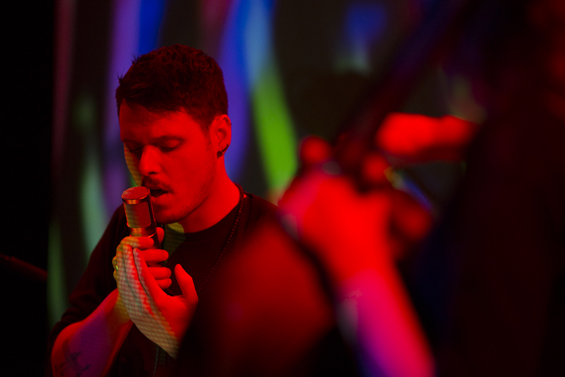
MOUNTING THE FOUR PILLARS
TEN QUESTIONS WITH RANDY GIBSON
TEN QUESTIONS WITH RANDY GIBSON
Avant Media curator and NY-based composer Randy Gibson has stated of his Apparitions of The Four Pillars in The Midwinter Starfield Under The Astral 789 Duet, “My ultimate goal with my work is to create a fully enveloping meditative experience that allows the listener to transcend time and place and be fully in the performance.” That particular goal was achieved in unforgettable manner for this listener when the work was presented in Manhattan on March 1st, 2014 as this year's festival closer. Time seemed to gradually suspend itself as the piece unfolded, from its full drone beginning until its eventual finish 190 minutes later. In between, the six musicians—Gibson (voice and sine waves), Jen Baker and William Lang (trombones), Drew Blumberg and Erik Carlson (violins), and Meaghan Burke (cello)—collectively generated an hypnotic mass of slowly mutating sound that advanced almost imperceptibly through multiple stages; mention also should be made of the critical contributions made by Oscar Henriquez (video sculpture) and Kryssy Wright (lighting design) to the work's presentation. Shortly after the performance, the composer spoke with textura at length about Apparitions of The Four Pillars and other projects, including The First Pillar Appearing in Supernova, his recent cassette release on the Important Records sub-label Cassauna.
01. Now that the 2014 Avant Music Festival is over, I'm curious to hear your impressions of the festival in terms of how successful it was, artistically and otherwise. And how has the public and media response to the festival been?
This year's festival felt really wonderful. I was extremely proud of the performances we presented and the diversity they represented. Alvin Lucier wrote a remarkable new vocal work for Joan La Barbara to perform and getting to work on the electronic elements of that performance was incredibly exciting and rewarding. We also presented John Cage's Europera 5, which is something that Kryssy Wright (our lighting designer) and I have been dreaming of doing for years.
The response we've gotten to the festival is really great. When Megan Schubert and I set out to put together our first one, we never could have dreamed where it would take us. But in the last couple years, we've both really felt like we've become a fixture of the downtown scene in New York and that we're offering composers a really special opportunity to do that crazy thing they've always been thinking of but haven't had the right place. Being able to help bring these works to fruition is extremely satisfying.
02. Since 2003 you've studied with La Monte Young and since 2005 raga singing in the Kirana tradition with Young and Marian Zazeela. Are those studies still carrying on today and, if so, how frequently? What does a typical lesson consist of?
I do still study with Khan Sahib La Monte Young, Marian Zazeela, and Jung Hee Choi. I'll have a formal lesson every couple of months, but really, it's about so much more than that. Every moment with them is an education; I'm constantly learning, and they're constantly pushing me to learn more and be better. I come from a very independent background, educationally: I got kicked out of a few schools, I would drive my music teachers to quit, and I dropped out of University after two weeks, but it was always because I was questioning, pushing the boundaries, finding my own way.
From the first moments I spent with Khan Sahib and Marian, which was a late-night composition lesson sometime in 2003, I knew that under their tutelage I would find my right path. Khan Sahib is a truly remarkable teacher and is incredibly supportive of the work that I do. Whether it's hearing a story of the great masters of the past, passed down through the generations, or Khan Sahib selecting a raga for me to learn that, through lots of practice will move my voice to the next level and give me a deeper understanding of the form or reflect some aspect of my own compositions, or something as simple but profound as a blessing at the end of the day on my way home, or those silent moments of contemplation after a performance. It's all a part of a bigger picture that I know is just the beginning of a long and transcendent journey.
03. Let's discuss the March 1st performance of Apparitions of The Four Pillars in The Midwinter Starfield Under The Astral 789 Duet that was presented in Manhattan. First of all, given that the piece has been presented before (albeit in different configurations), was this latest presentation, with its arrangement for two trombones, two violins, cello, voice, and sine waves, the most fully realized one to date?
This was the best performance of the work to date, and I think the best ensemble I've had as well, which is a big part of it. I'm constantly revising, improving, and building this idea of Apparitions of The Four Pillars. The earliest incarnations of this work relied heavily on the mathematical relationships of the tuning, separating out each “Pillar” and then combining them. These versions were very successful and taught us a lot about how the piece could function; they were sort of prototypes for what the piece could become. In 2012, I presented two different versions of the work, Circular Trance Surrounding The Second Pillar, a seventy-minute septimal raga written for the vocal ensemble Ekmeles, and The Third Pillar in Primal Imperfect Palindrome, a two-hour-plus work for solo trombone written for William Lang, who has been performing Apparitions with me since I began working on it. This was a new way of really delving deeply into a single aspect of the work, and I learned a lot from how these pillars could function as their own entity.
Last year we presented a work with the same title as this year, and the two are clearly related, although this year's approach to the material felt much more free and natural, whereas last year we had used a slightly more traditionally notated score. I think the listener would clearly hear the two pieces as the same piece, but for us as performers, this year's version felt like a major step forward. We were really all focusing and performing at a very high level, and it felt like a great spiritual communion.
04. In reflecting on the concert, I was reminded of a recent review of a Morton Feldman recording in The Wire in which the writer commented on the above-average degree of concentration required by both the musicians and listeners for the respective performance and reception of the work. How draining an experience is it for you and the other musicians to perform Apparitions of the Four Pillars, given the degree of concentration involved in performing a work of 190-minute duration? And what kind of pre-concert preparation is undertaken to get such a work ready for presentation?
It's incredibly draining. You're right, the degree of concentration that we have to maintain is extremely high, not only to perform for these sorts of durations, but also to be tuning as accurately as we are and listening to each other in this highly active way. We are functioning as a unit on stage, and having this hyper-sensitivity to what everyone else is doing as well as to what you, yourself, are contributing is very, very draining. In many ways, the duration is the least strenuous aspect of the work. After the performance this year, as we were collecting ourselves backstage and sharing our feelings with each other, several of the performers remarked that they felt like they could have gone another half hour or so, at least.
You know, I don't write with the duration in mind, unless it needs to be something quite short; I just think about what I need to say and let it happen naturally. So while the duration is certainly an aspect of the preparation, the mechanics of being on stage (comfort, hydration, etc.) for that long are one thing, I think our biggest challenge is a mental one.
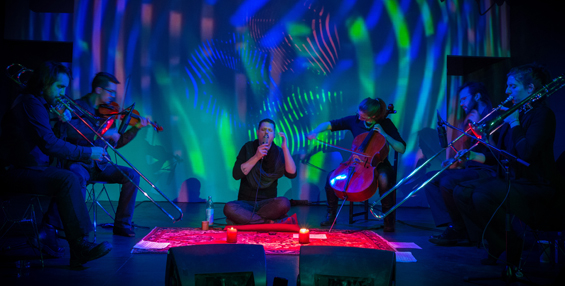
05. Could you elaborate on the guidelines that the musicians operate within as they play the piece and to what degree those guidelines allow them to improvise?
This was the area where we had the greatest improvement this year. Last year the score was two pages long, and the performances lasted around two hours, much shorter than I thought it would be, whereas this year the score was only a single page, and the performance was just over three hours. Basically, the score is a series of chords, with an approximate duration assigned to them based on a single statement of the melody that happens within the drone at the highest range of our hearing. There are set ways that we move through each chord, as well as specific pitches for us to focus on, but the entire composition, except for a short moment near the end is completely improvised. I've been working with most of these performers for a long time, and we can listen to each other and understand what is needed to make the work a success, and so because of this I've been able to make our guidelines more freeing, allowing us to focus on creating beauty in the moment, with each other, rather than feeling tied to some notes on a piece of paper.
06. One of the most compelling issues that arises from the listener's experience of the work has to do with time, and I'm not referring to simply the detail of the 190-minute length, even if that in itself is compelling. Listeners who grow up within the Western tradition bring to musical reception expectations about development within a given piece. One of the more fascinating things about Apparitions of The Four Pillars is that it challenges convention by having development occur at a much slower pace, a move that in turn brings about a corresponding adjustment, a recalibration if you prefer, within the listener. If I'm remembering the concert correctly, for example, as the musicians' onstage performance drew to its conclusion, their individual contributions grew ever more minimal until their playing ended altogether. Yet this development occurred in such a prolonged manner that it required a great amount of concentration for the listener to realize that the material was being reduced in this way. Could you describe, then, how notions of time and development operate in your work, as well as comment on how challenging it is for you and the other musicians to become comfortable in effecting that temporal adjustment in the material as it's performed?
I like the idea of a recalibration; that's really what it is. And I think this is one of the reasons I choose to include the approximate duration in the program. One of La Monte's most famous tenets is that “Tuning Is A Function Of Time,” and I try to keep that in mind when I'm performing. As Terry Riley has said, “Western music is fast because it's not in tune,” but if you look at Indian music, you see the tempo slow. The majestic alap of a well-rendered raga is stunning, and duration becomes an aspect there. One of my favourite concepts, and one that I return to over and over is from the alap of a raga, a concept called bhadat where each pitch is systematically introduced, slowly, and one-at-a-time, ascending the scale. I take this practice now as a method of structuring the chords of my work. Each subsequent chord introduces a single new pitch, and it's our job as performers to set that up so that when it happens, it seems like the logical next step and emerges naturally from the sound world we've built up. We don't even use the full scale available to us in this work until well past the two-hour mark. That's how I'm dealing with time on a grand scale.
One of the few concepts that I've held to from my early interest in the works and theories of John Cage is his idea of a micro-macro-cosmic relationship, “subdivision by a square root.” Basically it's the idea in a lot of his early works that every small section is related to every larger section proportionately. He was usually referring to rhythm when he talked about this, but you can apply it to any aspect of the composition. So in this piece there is the vertical statement of the scale, the drone in which we perform, then at the next level down is this single statement of the central melody within that drone that takes a little over three hours. Each chord that we're performing is based on the current melodic pitch that's changing within the drone, and our moment-to-moment thinking concerns this melody as well. It's the idea that every aspect of the work is interrelated and connected.
As performers, this temporal shift happens quite naturally. As I've already said, these musicians have been performing with me for a long time. Drew Blumberg has been playing my work since about 2002, and William Lang has been performing it since 2010. I choose musicians to work with that have, in addition to the technical proficiency to be able to perform the tunings, the right demeanour and personality to perform it effectively. Mariel Roberts, a truly gifted cellist, wasn't able to perform this year, but introduced me to Meaghan Burke who is equally phenomenal. When I first met Meaghan and told her about the duration, the idea was met with an enthusiastic thumbs up and a “Great!”—that's the kind of performer I'm looking for. So I think that our own comfort with the scale of the work comes across to the listener in a way that guides them gently into this sort of time-scale.
07. It was fascinating to see that after the musicians' contributions to the work ended and they left the stage, there was no applause but instead silence, with the only sound remaining the drone. How do you account for that response, and is it characteristic of the audience's response to the work? Is it less satisfying for those performing not to receive the immediate gratification of applause?
It's interesting you mention this. A long time ago Pandit Pran Nath established the idea of no applause after his concerts, which, I think goes back to a more serious, religious, spiritual approach to music which Guruji promoted, and La Monte and Marian have followed this practice as well. So every single concert of theirs that I've been to has not had applause at the end. Applause really acts as a reset button on the experience, and if we're interested in creating something eternal, then why would we break that with applause? You hit the nail on the head here mentioning “the musicians' contributions to the work”—this is exactly right: the drone continues and is as much a part of the composition as what we do as performers. I never had to tell the audience not to applaud, but last year, we made a conscious decision to just not encourage it, to remove the visual cues that we are so attuned to. I discussed it with the performers last year, and they all agreed that it would be nice to not have the interruption of applause, to really let the vibrations continue. And they did, we finished performing and left the stage, the drone didn't change, the lights didn't change, the video didn't change, and there was no applause. It actually feels really wonderful to have the drone keep going unimpeded, to allow the music to live on in our minds.
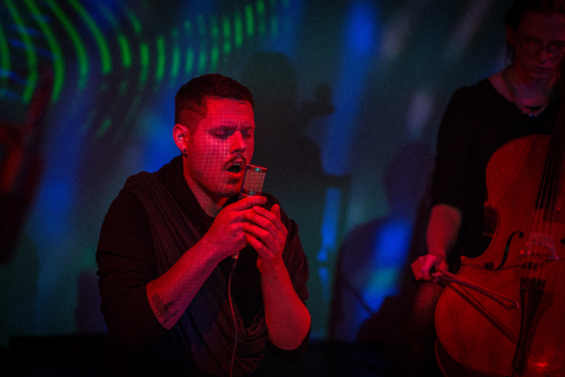
08. Let's shift the focus to your latest release, The First Pillar Appearing in Supernova, which was recently issued in a cassette format on Cassauna. First, in what way does this release, which features two half-hour settings, relate to the Apparitions of the Four Pillars, and, secondly, why is it being presented on cassette as opposed to, say, a CD format?
For the Cassauna release, I focused on cassette again, as I had for my earlier release Analog Apparitions for The Tapeworm. So the format is really a part of the piece. The vocal drones were recorded onto cassette and then manipulated on cassette into the pieces you hear. The dual-sided nature of cassette as well is interesting to me, and something I explored with these works.
To answer your question about how they relate to Apparitions, it's this: each side takes half of the scale and very slowly presents it as a chord. It's The First Pillar—24 32 36 27—on both sides, but on the first side 24 and 32 implode into the tones between that space, the Abyss, on the second 24 and 36 move outward to 32, filling in The Midwinter Starfield.
This was all done one pitch at a time on a variable-speed cassette player and layered. The first side is exclusively voice, the second side has a bit of violin, but once the full chord is sustained it becomes otherworldly. Someone jumping into the work in the middle probably wouldn't immediately recognize the instrumentation.
09. As you're aware, I greatly admire your Just Intonation piano recording, Aqua Madora, which was chosen as one of textura's top 10 albums of 2011 (reviewed here). Are there any plans to do another piano album as a follow-up?
I'm actually working on a new piano piece for the amazing pianist R. Andrew Lee, known for his long-duration performances. It's going to be a part of the Apparitions of The Four Pillars family of works, but will use a new technique I've been developing for adjusting the harmonic language of the piano, and I'm hoping we'll be able to release a recording of that piece at some point.
10. Admittedly, a studio recording of a work rarely captures the magic of a live presentation. Nevertheless, it would be wonderful to have Apparitions of the Four Pillars available in a physically documented form. Is there any chance of that happening someday?
I'd love to release a recording of this work, but it would most likely be a live recording, as Aqua Madora was. The magic of a live performance is really something, and, I think with this piece, the recordings are clean enough that one could potentially be releaseable.
It's really a matter of figuring out the right format to release something that is over three hours long without cutting it up into chunks, which I simply wouldn't want to do. Perhaps a DVD would be the right choice. - www.textura.org/reviews/tenquestions_randygibson2014.htm
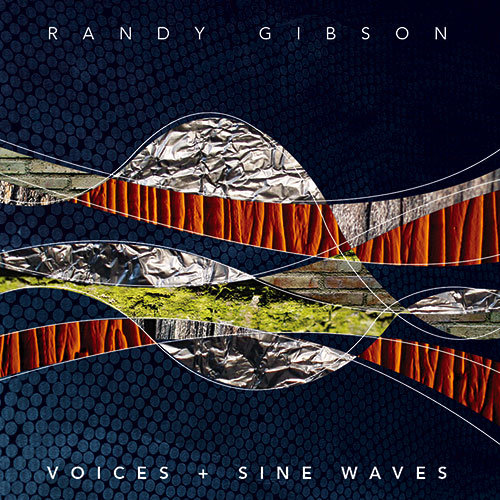
Voices + Sine Waves (2009)
randygibson.bandcamp.com/album/voices-sine-waves
These works represent the most primal and basic of materials; voices ethereal and guttural; sine waves pure and distorted. Most of these pieces have been scores for short films or dances, but exist on their own as recordings of a single performance. Exclusive to this CD release, and not available for download, is the rāga influenced "The Third Pillar with its Lowest Primes and Memories of The Second Pillar from Apparitions of The Four Pillars III-iii-2010 20:02:56" - 20:20:17" (Brooklyn) performed by Randy Gibson, Will Lang, and Drew Blumberg.

Ekmeles in music by Randy Gibson Photo: Tear-N Tan
Circular Trance Surrounding the Second Pillar with The Highest Seventh Primal Cirrus, The Utmost Fundamental, and The Ekmeles Ending from Apparitions of the Four Pillars
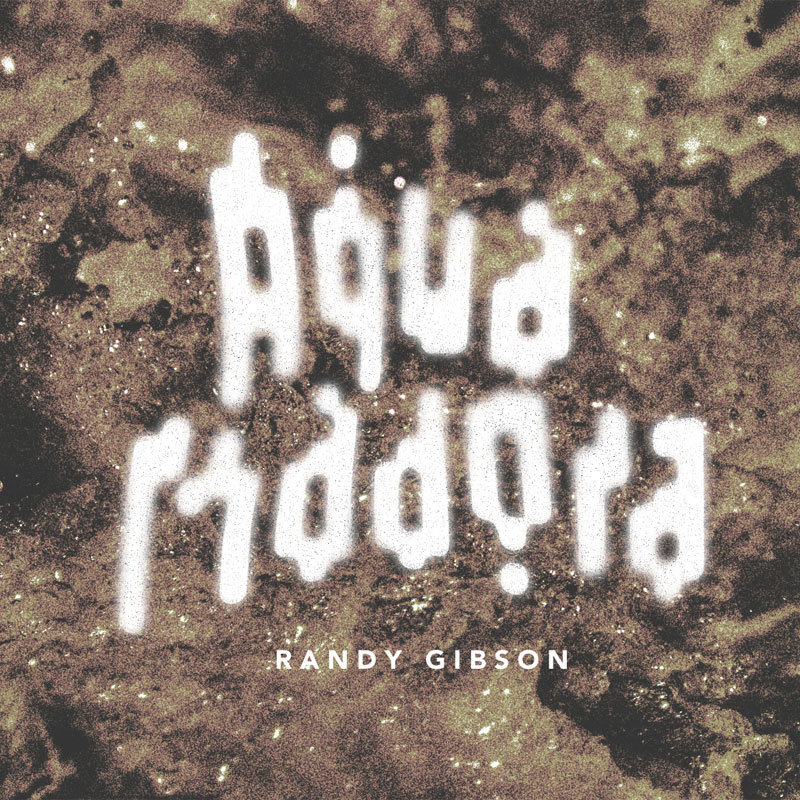
Aqua Madora V-ii-2008 21:07:26" - 21:54:40" (NYC) (2011)
randygibson.bandcamp.com/album/aqua-madora-v-ii-2008-21-07-26-21-54-40-nyc
Alicia
Anger
Aqua Madora
La Balada del Güetback
City_M-Y
Doleo Æternusi left you on a cold day in december
Jetta
Mémoire-en-Ciel
Mujeres de Juárez
One Wall
Pressure
Room
Shiver
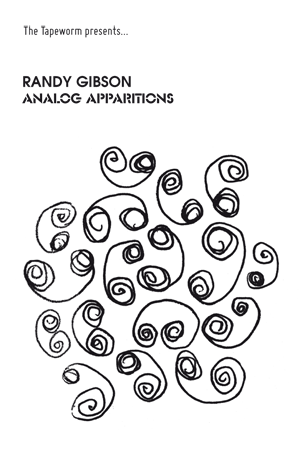
Heavyweight harmonic drones from the always surprising Tapeworm imprint. Brooklyn-based composer, Randy Gibson, was a student of famed minimalist La Monte Young and his two compositions here are firmly rooted in the studied traditions of his tutor. Given the quite specific titles of “The First Analog Pillar with its Simplest Primes and The Harbinger of The Second Pillar with The Low Modora Cornerstone and The Outlying Primal Cirrus from Apparitions of The Four Pillars”, and “The Third Analog Pillar with its Lowest Primes and The Ersatz Souvenir of The Second Pillar with The High Madora Cornerstone and The Outlying Primal Abyss from Appararition of The Four Pillars” you basically know this guy isn't just f**king about. Crafted from eighteen hours of recordings layered over two sides, these compositions are concerned with the just-intonation and “purity of sine waves in complex prime-harmonic relationships” which sounds incredibly intimidating, but is actually quite beautiful, if you've ever succumbed to the work of La Monte Young, or felt your chakras quivering while listening to the likes of Eleh. The experience is ritualistic and enveloping and shouldn't be undertaken while operating heavy machinery. - boomkat
One of three new releases on UK cassette label The Tapeworm, this one featuring two sprawling side long excursions into just intonation drone from Brooklyn composer Randy Gibson, a student of legendary minimalist composer La Monte Young. Gibson fuses the traditional concepts of prime harmonic just intonation with modern tape manipulation, the tones as important as the mechanisms producing them, the sounds lush and layered, heaving and undulating, overtones and subtle sonic colors, rife with subtle shifts, tape speed inconsistencies, peppered with bits of hum and hiss, crunch and creak, a sound more organic and human than clinical and composed, the sounds seeming to breathe and expand, some serious deep kosmische drift for sure.
The two sides here are created from 18 hours of recordings condensed into two half hour epic swaths of deeeeeep rage like dronemusic, the sound constantly evolving and mutating and subtly shifting, from ethereal hazy shimmer to thick reverberating metallic buzz, a gorgeously expansive dronescape created using just voice, cassette boomboxes and just intonation toy organs. Wow.
Total deep drone blissout for sure. Essential listening for the aQ dronemusic faithful...- Aquarius Records

Voices + Sine Waves (2009)
randygibson.bandcamp.com/album/voices-sine-waves
These works represent the most primal and basic of materials; voices ethereal and guttural; sine waves pure and distorted. Most of these pieces have been scores for short films or dances, but exist on their own as recordings of a single performance. Exclusive to this CD release, and not available for download, is the rāga influenced "The Third Pillar with its Lowest Primes and Memories of The Second Pillar from Apparitions of The Four Pillars III-iii-2010 20:02:56" - 20:20:17" (Brooklyn) performed by Randy Gibson, Will Lang, and Drew Blumberg.

Ekmeles in music by Randy Gibson Photo: Tear-N Tan
Circular Trance Surrounding the Second Pillar with The Highest Seventh Primal Cirrus, The Utmost Fundamental, and The Ekmeles Ending from Apparitions of the Four Pillars
Of the five-night Avant Music Festival, the two nights I caught seemed an almost ideal snapshot of what its curators – Randy Gibson and Megan Schubert – have in mind. On the first evening, listeners who entered the dimly lit Wild Project space (an appealingly intimate venue in the East Village) met a sensory catalog: the hum of a sine wave, the air slightly smoky with incense, microphones onstage surrounding a rug with two candles in the center, and a slowly evolving video by Oscar Henriquez – abstract shapes in reds, purples and greens – projected on the stage’s back wall.
Gibson’s opus might have the longest title I’ve ever encountered: Circular Trance Surrounding the Second Pillar with The Highest Seventh Primal Cirrus, The Utmost Fundamental, and The Ekmeles Ending from Apparitions of the Four Pillars. Slightly over sixty minutes long, it was written for the vocal group Ekmeles, directed by Jeff Gavett, who’s also one of its baritones. As the sine wave continued, the seven singers slowly entered from behind the stage, quietly took their places and gradually began to join the electronic tone with their own syllabic chanting. (The texts are in Sanskrit, culled from the Rig Veda, an ancient Indian book of hymns.)
Gibson’s trance-oriented esthetic reflects his rāga studies with composer La Monte Young and his wife, visual artist Marian Zazeela, and (with a few reservations) I found the piece fascinating. Circular Trance is built on the vocalists’ ability to produce pure harmonies that combine with the sine drone, creating a shimmering cloud of sound. During the hour, the voices would ebb and flow – sometimes emerging from the drone, at others being engulfed by it. The effect was often hypnotic, and it was a marvel just watching the singers tackle Gibson’s minute changes in pitch, often with tones sustained for long stretches of time.
My sole concern was due to a program note, “portions of tonight’s performance may be at an extreme volume,” which made me apprehensive, worrying if the sound level would equal say, the atomizing charge of Rhys Chatham’s Two Gongs. As it turned out, the level was gratefully stable but still felt slightly too forward (on a 1-to-10 scale, maybe a 5 or a 6), like standing next to a loudspeaker emitting mild feedback. Despite the richness of the ethereal tones being produced, I wondered if the result might have been even more successful if the voices and electronics had been more equal partners. Nevertheless, there were still many moments of transcendence.
The second night was a tribute to John Cage, whose centennial is being marked all over the world. A soulful touch: a small potted plant – a cutting from a larger one that originally belonged to the composer – was carefully placed on the floor throughout the concert. Living Room Music was deftly performed by the four members of loadbang (Alejandro T. Acierto, Mr. Gavett, William Lang and Andrew Kozar), merrily smacking their palms on the floor, on books and magazines, on a coffee table. One section uses text by Gertrude Stein: “Once upon a time the world was round and you could go on it around and around.” If the performance here didn’t quite have the amusing context of a recent Juilliard version, the quartet scored points for clarity and simplicity, of which I suspect Cage would have approved – not to mention the book resting on the table: The Chicago Manual of Style.
Before the concert began, Gibson asked the audience to flip coins to help decide the lighting design (nicely handled by Kryssy Wright) for Concert for Piano and Orchestra. (The word “concert” is used deliberately, reflecting the composer’s intent that all members of the ensemble are to play at once, but without any particular relationship to each other.) Vicky Chow was the admirable pianist, immersed in an octet of musicians playing, talking, singing, whispering – but as if each were in a private world.
Next came the stark Ryoanji, with Lang on trombone, Schubert as vocalist, and Gibson carefully striking a drum and a wooden stick simultaneously, one with each hand. Ms. Chow returned for the glittering piano part in Nocturne, with violinist Drew Blumberg in icy counterpoint, figuratively skating above her. The program closed with Four3, one of the composer’s last works, with Blumberg, Chow, Gibson and Lang seated on the floor, each with an array of rainsticks (hollow tubes of various sizes with small objects inside, which when slowly tilted create a soothing replica of droplets falling). Periodically one of the musicians would rise and slowly walk to the piano, softly pressing a key or two, while on the back wall, Elliot Caplan’s film of Beach Birds For Camera flickered onscreen. As I watched the silence of Merce Cunningham’s dancers (filmed in black-and-white), the result took on a poignant cast that I could not have possibly anticipated.
- Bruce Hodges

Aqua Madora V-ii-2008 21:07:26" - 21:54:40" (NYC) (2011)
randygibson.bandcamp.com/album/aqua-madora-v-ii-2008-21-07-26-21-54-40-nyc
Not many recordings include a credit for the piano tuner, but in the case of Randy Gibson's Aqua Madora, it seems entirely appropriate, as it's a recording featuring Gibson playing in just intonation using a just intonation Estonia 190 piano (its full title is Aqua Madora - for Just Intonation Piano and Sine Waves). Begun in 2005, the work is notable on mulitple counts: it's heavily influenced by the compositional studies Gibson initiated with La Monte Young in 2003 plus Gibson's raga studies in the Kirana tradition with Young and Marian Zazeela; and it's a work that grew out of a video-dance collaboration Gibson undertook with Ana Baer-Carrillo. As conceived, the work is based on themes of water and mourning, hence the Aqua (water) Madora (sorrow) title, and was premiered in June, 2006 with the video (featuring Dani Beauchamp) establishing the dramatic arc of the material. The Brooklyn-based Gibson, who complements the live presentation of his ritualistic just intonation works with incense and lighting, is also artistic director of Avant Media, a non-profit organization dedicated to collaborative artistic endeavors, and co-curator of the Avant Music Festival.
Aqua Madora is forty-seven minutes in length and comprised of six separately titled sections presented without interruption. That it was recorded live in concert on May 2, 2008 at the Gene Frankel Theatre in New York City is at times apparent in the occasional creak of a bench and cough, but such touches only humanize the recording. Appropriate to the title's water allusion, the reverberations produced by the piano's sustain creates an impression of fluidity between the notes played, as if they possess a liquidy dimension that allows them to flow into one another. In the opening part “Alap,” soft sine tones are the first sounds heard, after which sparsely distributed piano pitches appear, with each one introduced slowly (a method of pitch introduction called 'badhat') while the sine tones persist as an underlying drone. The just intonation dimension of the work is readily apparent in pitches that will at first strike the listener accustomed to standard tunings and conventions of harmony and consonance as unusual, but adaptation sets in quickly. Without interruption, Aqua Madora carries on into “Drone (Skyline)” with stately chords announcing its onset and Gibson's playing growing more rapid, intense, and, with the playing swelling into multiple layers, denser. “Bed” alternates between reflective and more aggressive passages before the thick clusters of “Drone (Ice Flow),” a remarkable twelve-minute section, appear to take its place. “Table” again arrests the driving forward movement and replaces it with a ponderous and spacious eight-minute meditation, the generous spaces between the notes enabling the sine tones to once again be heard.
This is a special recording that'll appeal to not only listeners interested in La Monte Young and Charlemagne Palestine but more generally those with an appetite for innovative piano-based work. Gibson has made it available in two physical editions, a limited-edition digipak CD (70 copies) that includes a booklet with program notes from the recorded performance and a hand-embellished version (30 copies) that's hand-numbered, signed, wrapped in handmade Japanese paper, scented with roses, and sealed with wax. Oh, and that piano tuner? His name's Kaz Tsujio. - www.textura.org/reviews/gibson_aquamadora.htm
Composer Randy Gibson’s 50 minute long Aqua Madora, for sine wave drones and piano tuned in just intonation, is an exquisitely lovely piece. Gibson uses his studies of tuning systems, composition, and singing with LaMonte Young and Marian Zazeela as a jumping off point – even going so far as to tuning some of the intervals (particularly seventh scale degrees) in homage to these masters of early minimalism.
As touching as this tribute is, especially at a time in which the importance of Young’s work is not nearly as widely known as it should be, Aqua Madora is not just about expressing gratitude for knowledge transmitted between teacher and student. In collaboration with Ana Baer-Carrillo and Dani Beauchamp, Gibson spent a long time refining this piece as a multimedia work containing film and dance.
One needn’t have these visual elements to enjoy the suppleness and subtleties of Aqua Madora’s music. Gibson’s play with intervals that sound “out of tune” to those accustomed to equal temperament is particularly sensitive. He allows the tangy appearances of these notes to color the drift of harmonic progressions and provide fascinating variants that add a tinge of the unexpected to scalar passages.
- www.sequenza21.com/carey/2011/08/justly-blissed-cd-review/Alicia
Anger
Aqua Madora
La Balada del Güetback
City_M-Y
Doleo Æternusi left you on a cold day in december
Jetta
Mémoire-en-Ciel
Mujeres de Juárez
One Wall
Pressure
Room
Shiver

Heavyweight harmonic drones from the always surprising Tapeworm imprint. Brooklyn-based composer, Randy Gibson, was a student of famed minimalist La Monte Young and his two compositions here are firmly rooted in the studied traditions of his tutor. Given the quite specific titles of “The First Analog Pillar with its Simplest Primes and The Harbinger of The Second Pillar with The Low Modora Cornerstone and The Outlying Primal Cirrus from Apparitions of The Four Pillars”, and “The Third Analog Pillar with its Lowest Primes and The Ersatz Souvenir of The Second Pillar with The High Madora Cornerstone and The Outlying Primal Abyss from Appararition of The Four Pillars” you basically know this guy isn't just f**king about. Crafted from eighteen hours of recordings layered over two sides, these compositions are concerned with the just-intonation and “purity of sine waves in complex prime-harmonic relationships” which sounds incredibly intimidating, but is actually quite beautiful, if you've ever succumbed to the work of La Monte Young, or felt your chakras quivering while listening to the likes of Eleh. The experience is ritualistic and enveloping and shouldn't be undertaken while operating heavy machinery. - boomkat
One of three new releases on UK cassette label The Tapeworm, this one featuring two sprawling side long excursions into just intonation drone from Brooklyn composer Randy Gibson, a student of legendary minimalist composer La Monte Young. Gibson fuses the traditional concepts of prime harmonic just intonation with modern tape manipulation, the tones as important as the mechanisms producing them, the sounds lush and layered, heaving and undulating, overtones and subtle sonic colors, rife with subtle shifts, tape speed inconsistencies, peppered with bits of hum and hiss, crunch and creak, a sound more organic and human than clinical and composed, the sounds seeming to breathe and expand, some serious deep kosmische drift for sure.
The two sides here are created from 18 hours of recordings condensed into two half hour epic swaths of deeeeeep rage like dronemusic, the sound constantly evolving and mutating and subtly shifting, from ethereal hazy shimmer to thick reverberating metallic buzz, a gorgeously expansive dronescape created using just voice, cassette boomboxes and just intonation toy organs. Wow.
Total deep drone blissout for sure. Essential listening for the aQ dronemusic faithful...- Aquarius Records
The Education of Randy Gibson
Plenty of composers flourish within the halls and harbors offered by academia, developing their artistic voices and finding their professional footing; Randy Gibson understood pretty quickly that he wasn’t one of them. While his education now spans training in composition, electronic music, and percussion—including the study of Balinese gamelan, traditional Japanese music, and raga singing—only a portion of that instruction occurred within the confines of the typical classroom. After two years of part-time attendance at the University of Colorado, Boulder, his try at full-time composition study ended after two weeks.
“The university experience was not really for me,” Gibson admits with a shy laugh. A year later, he moved to New York and began studies with La Monte Young. “It was a much larger, more interesting education, I think, than I could have gotten at the school, and I’ve never regretted it.”
If the three-pages-and-growing list of compositions which now crowd his C.V. is any indication, it’s a path for which he need make no excuses. It is, however, one for which he offers a great portion of credit to the role Young has played in his development.
“As soon as I went to my first composition lesson with him, it really just opened my ears and my mind to what had already been present in my work,” Gibson recalls. “These repeated structures, these slow tempos, these longer statements—my studies with him really sort of freed me to be able to explore those and really take them as far as I could.”
The relationship proved to be “a perfect fit,” their first lesson beginning just after midnight and ending six hours later. Though Gibson began by studying composition with Young, that eventually expanded to include raga singing as well, providing additional revelations concerning the structure and the character of the music he wanted to write. He traces subsequent works such as his Aqua Madora (for just intonation piano and sine wave drones) firmly back to this study and the influence of Young, particularly the example provided by The Well-Tuned Piano.
While Gibson is careful not to simply co-opt the music that he’s encountered through his studies, the ritual of presentation in traditions such as raga singing speak to him deeply. Using lighting and incense, he surrounds his own audiences in an experience from the moment they enter the performance space. The compositions themselves explore form and tuning in a way that often leaves room for variation and further exploration with each performance. Out of just intonation, sine waves, extended durations, and close collaborations, Gibson is building a vocabulary for his work that has carried him deeply into a particular sound world alongside a special group of performers who are up for the challenge. This is particularly evident in the large-scale frameworks of pieces such as Doleo Æternus (for soloists, drone performers, and rhythmic performers [any variable pitched instruments] and computer; 90-120 minutes) and Apparitions of The Four Pillars (an evolving composition model for just intonation toy organs, variable pitched instruments, prime harmonic sine waves and harmonically related delay lines; variable durations). If these complexities mean the pieces are not destined to become part of the standard repertoire, that’s fine—that’s not Gibson’s goal. He’s looking, rather, to create a particular and immersive experience for his audience.
Yet even if the strategy of following “an all encompassing theory in which I can create new things” appeals to Gibson, he doesn’t need to yolk the audience with the details. “What I want to pursue is stuff that is beautiful and stuff that is powerful and emotional and is complex, but there’s a simplicity to it,” he explains. “The audience member doesn’t care if it’s the 81st harmonic or the 1331st harmonic. From the audience standpoint, it’s about how the music sounds.”
Admittedly, this may still not be for everyone. “But nothing is,” he acknowledges, “so why not just do the best that I can at what I really want to do.” - www.newmusicbox.org/articles/the-education-of-randy-gibson/
.5 Questions to Randy Gibson (composer, co-founder of Avant Media)
Randy Gibson is a composer and performer living and working in New York City. He is the co-founder of Avant Media, and produces the Avant Media Festival, which showcases experimental music from the last 100 years and today. The Fourth Annual Avant Media Festival will take place February 15-23.
As has been mentioned in other interviews, you left the traditional university education route to go to NYC, eventually becoming a student of La Monte Young. Could you talk a bit about the circumstances that prompted the move away from academia?
Well, I’ve always had a difficult relationship with organized education, even from a very early age. I attended Montessori school, and I think the self-guided nature of that was extremely beneficial for me. In high school, I was in a sort of unique situation in that the town where I grew up had this amazing University, and a program where, as long as it wasn’t offered by the high school, you could take classes there. So I took full advantage of that, I studied theory and ear training, I took a fantastic class in 20th Century theory where I was one of only three students, and I took an interdisciplinary performance class helmed by my then composition teacher, Michael Theodore. This was a truly extraordinary class, and I met some amazing people and learned how to collaborate. I founded Avant Media with Ana Baer-Carrillo who I met in this class.
When I went to the university full-time, this freedom was suddenly gone, and I couldn’t pursue the things that I truly wanted to pursue. It was actually an incredibly easy decision for me to leave the composition program there and move to New York and just see what happened.
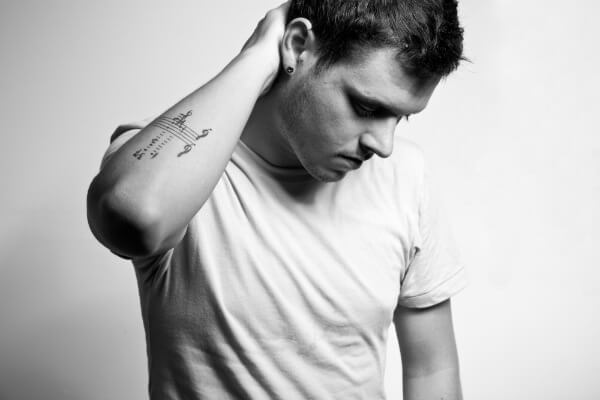
Randy Gibson
As you’re coming up on a decade of studying with La Monte Young this year, how would you say your own music has evolved in that time? There are obvious surface-level connections between your music and Young’s, e.g. duration, sine waves, and tuning, but I’m curious about how you’ve incorporated these ideas in finding your own voice.
At that first composition lesson, I was still very much finding my voice. There had been these themes running through my work up to that point: repetition, extremely slow tempo, fluidity, unrepeatability; but they were sort of all just in a cloud, floating around with no real direction. La Monte helped to clarify the situation for me, to allow the space for my sounds to be their own.
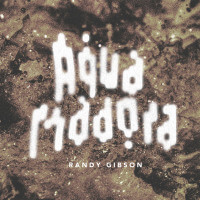 I had been working with electronics, but in this very unfocused way. Through examples like The Base 9:7:4 Symmetry… and Just Charles And Cello In The Romantic Chord I began to take these generated sounds I was using and order them according to the rules of just intonation. With Aqua Madora (my just intonation piano work with sine waves), I began to really explore how the vibrations of these intervals could encourage very deep feelings. My interest in purely generated electronic sound has been long-standing; I never wanted to work with “traditional” synthesized sound, and if I was going to work with electronics, I wanted it to be because electronics were the only way to realize something. The purity of sine waves, especially, appealed to me; the simplicity of them, and their potential for great complexity. Through La Monte’s uncompromising example, I feel like I am finally developing my own artistic language, uniquely my own, but deeply rooted in the tradition he pioneered.
I had been working with electronics, but in this very unfocused way. Through examples like The Base 9:7:4 Symmetry… and Just Charles And Cello In The Romantic Chord I began to take these generated sounds I was using and order them according to the rules of just intonation. With Aqua Madora (my just intonation piano work with sine waves), I began to really explore how the vibrations of these intervals could encourage very deep feelings. My interest in purely generated electronic sound has been long-standing; I never wanted to work with “traditional” synthesized sound, and if I was going to work with electronics, I wanted it to be because electronics were the only way to realize something. The purity of sine waves, especially, appealed to me; the simplicity of them, and their potential for great complexity. Through La Monte’s uncompromising example, I feel like I am finally developing my own artistic language, uniquely my own, but deeply rooted in the tradition he pioneered.The Avant Music Festivals have featured the music of John Cage quite a bit. What do you think draws you to Cage’s music, and how has his music influenced your own writing?
The thing I love about every time I get a new Cage score to begin working on is what a perfect little puzzle it is. Delving into his instructions, trying to unravel their intent, is an absolute joy. And then getting to realize that on stage, with an audience that is totally up for it, is just an amazing experience. We’re working right now on trying to figure out a realization of Variations IV for next year’s festival where the bulk of the material would actually be the set up for an evening performance of Europera V. I don’t know for sure if this will happen, but really seriously considering these sorts of things is what led to our realization of 49 Waltzes For The Five Boroughs; really carefully looking at the intent and realizing it was a way to listen, an impetus to go outside and hear the city around you.
Cage was really the reason I started writing music. I had been a percussionist (and a pretty good one) for a long time, but I heard a recording of Ryoanji and it just completely changed me. This was music that had nothing to do with anything I had ever heard, and I became obsessed. A lot of my early work was very heavily influenced by Cage: I used chance operations, did graphic scores, time brackets, etc.… Now I feel like that influence is still there, but more as an underlying spirit of openness, of letting sounds be sounds. My aims now are definitely different than when I started, but at my core I’m still a believer in Cage’s philosophy.
The annual Avant Music Festival is about to enter its fourth year and has featured an impressive array of performers and composers in that span. What have been some of the difficulties/lessons/surprises that you’ve encountered in that time while starting a festival from scratch?
You know, that first year, Megan and I really had no idea what we were doing, the first festival was put together from scratch in two months, with time to really plan now over the years we’ve honed in on what it is that we want to promote, what we felt was missing in the New York scene. This whole idea of focusing on the composers, the creators of the music, has been a touchstone for us. We really feel that this is something that’s not being done as much as it should be: composer-focused curation with a good dose of multimedia. This has always sort of been second-nature for me – It’s tough to do a multi-composer night when the work is well over an hour long – and my core desire is to create a complete experience for an audience. I think one of the biggest difficulties, but also one of the most rewarding aspects, in doing what we do now is getting this idea across: encouraging people to see a concert completely devoted to a single composer. I truly feel like this gives an audience a deep understanding of what it is a composer stands for, but maybe it’s easier to sell a concert with a bunch of diverse works, sort of something for everyone; I’m not really interested in doing things the easy way though.
I think the biggest surprise, and joy, for me is when a composer learns something about themselves. Last year we worked with Jenny Olivia Johnson as one of the featured composers, and it was the first time she had ever had more than one of her works played on a single concert. That was really rewarding, making that happen for someone. This year we’re working with two composers, Kitty Brazelton and Nick Hallett, who are both a bit more accustomed to concerts of their own music, but it’s really great – Kitty hasn’t really performed on this scale in New York recently, and so this is sort of a great homecoming, and Nick is making a really beautiful concert work that is focused and clever; I think will be a wonderful evening.
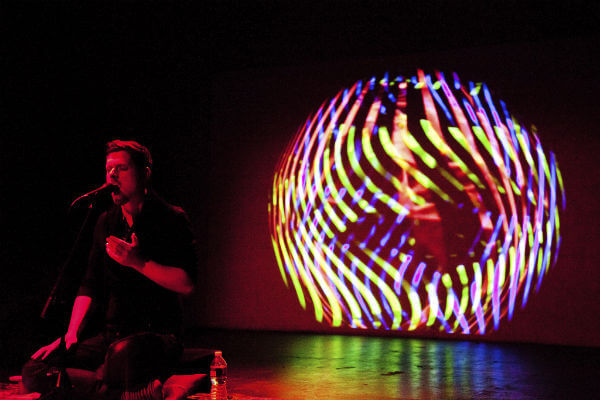
What’s next for you? What would you like to see Avant Media accomplish in the coming years?
I’m really excited about the piece I’m performing this year, and the group of performers. I’m hoping to be able to perform this work more and more. Last year I wrote a very large, expansive solo for the trombonist William Lang, and we’re working on finding some new venues to continue to refine and present that work.
For Avant Media, I really want to see us expand what it is that we can offer to the composers we program, to do more off-the-wall projects like 49waltzes.com and release more recordings. I’m hopeful that over the next few years we can continue to build the Avant Music Festival into a must-see event, and can use that to bring exposure to less-known composers who are creating beautiful work.
Compositions:
Nine Minutes for The Four Pillars in duet with The Paris Drones recalling The Midwinter Starfield Theme for violin and electronics - commissioned by Erik Carlson - 9 minutes - World Premiere: The Stone, New York, NY, March 26, 2013 :: Erik Carlson, Violin
Apparitions of The Four Pillars In The Midwinter Starfield Under The Astral 789 Duet for ensemble and prime harmonic sine waves - ca. 120 minutes - World Premiere: Wild Project, New York, NY, February 15, 2013 :: Randy Gibson, Voice; Drew Blumberg, Violin; Mariel Roberts, Cello; William Lang and Jen Baker, Trombones - video sculpture by Oscar Henriquez, lighting design by Kryssy Wright
The Third Pillar in Primal Imperfect Palindrome with The Souvenir of The Second Pillar, The Floating Cirrus over the Pumping Slush, and The Highest Moving Chordal Motif from Apparitions of The Four Pillars for solo trombone, digital delay, and prime harmonic sine waves - ca. 170 minutes - World Premiere: Wild Project, New York, NY, February 27, 2012 :: William Lang, Trombone - video sculpture by Oscar Henriquez
Circular Trance Surrounding The Second Pillar with The Highest Seventh Primal Cirrus, The Utmost Fundamental, and The Ekmeles Ending from Apparitions of The Four Pillars for seven voices and prime harmonic sine waves - ca. 60-70 minutes - commissioned by the vocal ensemble Ekmeles - World Premiere: Music At First, Brooklyn, NY, November 18, 2011 :: Ekmeles Vocal Ensemble - video sculpture by Oscar Henriquez
Apparitions of The Four Pillars with Their Lowest Additive Primes as limited to the 3rd, 7th, 9th, and 11th New Primes chosen Cyclically, The Toll of Premonition, The Memorial Connector over the Outlying Primal Abyss, and The Mid-Winter Ending - 110 minutes - World Premiere: Wild Project, New York, NY, February 11, 2011 :: Randy Gibson, Just Intonation Toy Organs; Will Lang, Trombone; Drew Blumberg and Catherine McCurry, Violins; Mariel Roberts, Cello - Performances in the Four Pillars series are accompanied by a video sculpture created by Oscar Henriquez
The Third Pillar (third version) composition based in Apparitions of The Four Pillars for prime harmonic sine waves, toy organ, voice, cassette boomboxes - 30 minutes - 2010. World Premiere as The Third Pillar with its Lowest Primes, The Analog TwentyFour Truckera, and The Ersatz Souvenir of The Second Pillar with The Madora Cornerstone and The Outlying Primal Abyss from Apparitions of The Four Pillars under a grant from the American Music Center: Cafe OTO, London, UK, December 9, 2010 :: Randy Gibson, Just Intonation Toy Organ, Voice; Dale Cornish and Parker, Cassette boomboxes
...........................
...........................
Nema komentara:
Objavi komentar